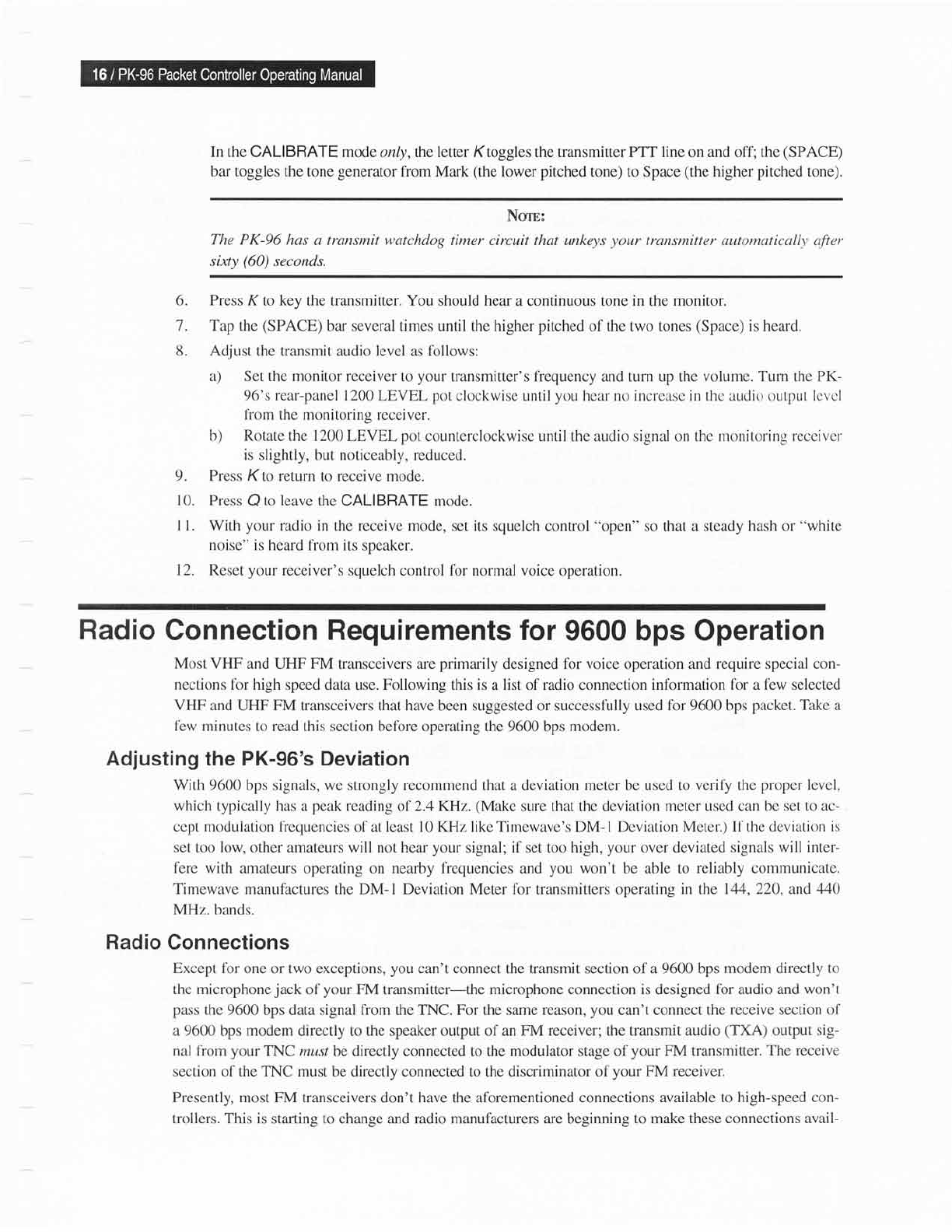Specifications
Table Of Contents

In the
CALIBRATE mode only, the letter Ktoggles the transmitter PTT line on and off; the
(SPACE)
bar toggles the tone
generator
from Mark
(the
lower
pitched
tone) to Space
(the
higher
pitched
tone).
NcnB;
The
PK-96 has a transmit watchdog
timer circuit that unkeys
your
tronsmitter automotically after
stxty
(60)
seconds.
6. Press K to key the
transmitter.
You
should hear a continuous tone in the monitor.
7 . Tap the
(SPACE)
bar several times until the higher
pitched
of the two tones
(Space)
is heard.
8. Ad.iust the transmit audio level
as
fbllows:
a) Set the monitor receiver to
yollr
transmitter's frequency
and turn up the
volume. Turn the PK-
96's
rear-panel
1200 LEVEL
pot
clockwise
until
you
hear
no
incrcase in thc audio clLrtput lcvcl
from the monitoring receiver.
b) Rotate the 1200
LEVEL
pot
counterclockwise until the audio
signal on
thc monitoring receivcr'
is
slightly, but noticeably, reduced.
Press Kto return
to receive mode.
Press
Q
to
leave
the CALIBRATE mode.
With
your
radio
in the receive mode, set its
squelch control
"open"
so that
a steady hash or
"white
noise"
is heard liom its
speaker.
Reset
your
receiver's
squelch control for normal voice operation.
9.
10.
ll.
t2.
Radio
Connection
Requirements for
9600 bps Operation
Most VHF and
UHF
FM
transceivers are
primarily
designed for voice operation and
require
special
con-
nections lbr
high speed data use. Following this is a list of radio connection information lbr a
I'ew
selected
VHF
and UHF FM transceivers that have
been
suggested or successlully used fbr 9600 bps
packet.
Take a
f-ew minutes to read this section
before operating the 9600 bps
modem.
Adjusting
the PK-96's Deviation
With
9600 bps signals, we strongly recommend that a deviation meter be used to
verify
thc
proper
level,
which typically has a
pcak
reading of 2.4 KIIz.
(Make
sr-rre that the
deviation
meter used can bc set to ac-
cept rnodulation f'requencies
of at least l0 KHz like Timewave's DM- I Deviation
Meter.) I['the deviation is
set
too
low,
other amateurs will not hear
your
signal; if set too high,
your
over deviated signals
will inter-
f'ere with amateurs
operating on
nearby
fiequencies and
you
won't
be able to
reliably communicate.
Timewave manufactures
the
DM-l Deviation
Meter for transmitters operating
in the 144, 220, and
440
MHz.
bands.
Radio
Connections
Except
fbr one or two exceptions,
you
can't connect
the
transmit section
of
a
9600
bps modem directly
to
the microphone
jack
of
your
FM transmitter-the microphone connection is designed for audio and
won't
pass
the
9600
bps
data
signal from
the
TNC. For the same reason,
you
can't connect the receive section
of
a 9600 bps modem directly to the speaker output of an FM receiver; the transmit
audio
(TXA)
output
sig-
nal
fiom
your
TNC must be directly connected
to the
modulator stage of
your
FM transmitter.
The receive
section ol'the TNC must be directly connected to the discriminator of
your FM receiver.
Presently, most FM transceivers don't have the afbrementioned connections available to
high-speed con-
trollers. This is startins
to chanse and
radio manufacturers are
besinnins
to make these connections
avail-










